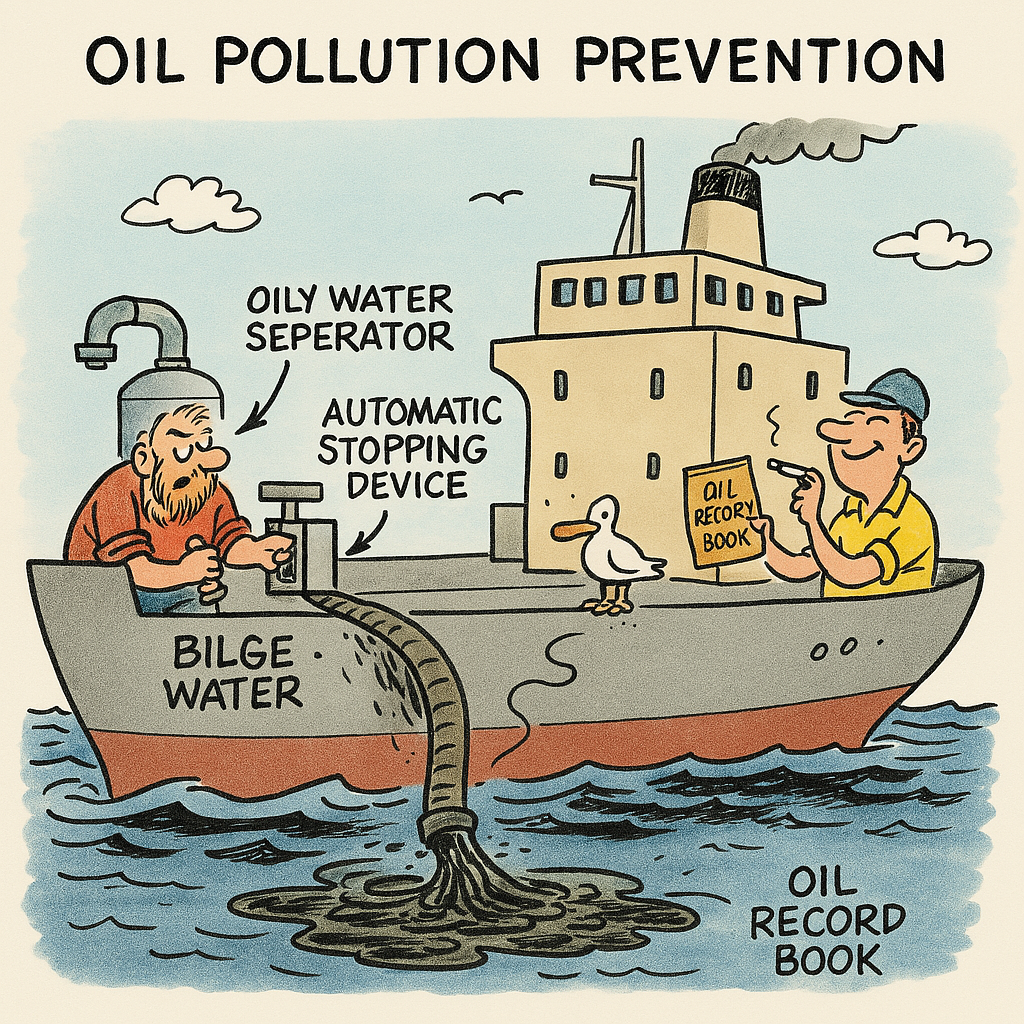Your cart is currently empty!

📘 MARPOL Annex I – Oil Pollution Prevention
Objective:
MARPOL Annex I aims to prevent pollution of the marine environment by oil, whether resulting from routine operations (like engine room discharges) or accidental spills (such as collisions or structural failures). It is one of the oldest and most important parts of the MARPOL Convention.
Scope of Application:
- Applies to all ships – not only oil tankers but also any vessel with fuel systems or machinery spaces.
- Sets rules for the design, equipment, operation, and control of oil discharge from ships.
Types of Oil Regulated:
- Crude oil and petroleum products
- Fuel oil (e.g. HFO, MGO, diesel)
- Bilge water containing oily residues from machinery spaces
- Ballast water contaminated with oil
- Sludge and oil tank washings
Key Technical Requirements:
⚙️ Equipment and Systems
- Oil Filtering Equipment (Oily Water Separator)
Must reduce oil content to below 15 ppm before discharge. - Oil Content Monitors and Automatic Stopping Devices
Stop discharge automatically if oil concentration exceeds the limit. - Sludge tanks, pumping systems, and dedicated discharge pipelines
for managing oily residues properly.
📘 Recordkeeping
- Oil Record Book (Part I for all ships, Part II for oil tankers):
All oil handling operations (e.g. discharge, transfer, sludge disposal) must be documented.
Discharge Regulations:
Discharging oil into the sea is strictly controlled and often prohibited. When allowed, the following minimum conditions apply:
- The ship must be en route (underway).
- Oil content of the effluent must be less than 15 ppm.
- The discharge must not cause visible traces of oil on the sea surface.
- The discharge must pass through compliant treatment equipment.
In Special Areas, the discharge of oil or oily mixtures is completely prohibited, regardless of concentration or treatment.
Special Areas:
Designated “Special Areas” under Annex I include:
- Mediterranean Sea
- Baltic Sea
- Black Sea
- Red Sea
- Gulf Areas
- Antarctic Area
- North West European Waters
These are ecologically sensitive regions where stricter controls apply due to their vulnerability and limited water exchange.
Structural Requirements for Oil Tankers:
- Double Hull Design:
Required for new oil tankers to reduce the risk of oil spills in case of grounding or collision. - Segregated Ballast Tanks:
Prevents mixing of ballast and oil cargo.
Emergency Preparedness:
- Ships of ≥150 GT must carry a Shipboard Oil Pollution Emergency Plan (SOPEP).
Tankers must have additional sections, including contact details for response authorities, action plans, and pollution reporting procedures.
Port Reception Facilities:
- Ports are required to provide adequate reception facilities for oily residues (e.g. sludge, bilge water), so ships are not forced to discharge at sea.
Enforcement and Compliance:
- Ships must be inspected for certification and equipment.
- Non-compliance can lead to detention, fines, or legal action under flag state or port state control mechanisms.
- Violations in Special Areas are taken particularly seriously.
✅ Summary:
MARPOL Annex I sets the global standard for oil pollution prevention at sea. It combines technical measures, operational rules, crew responsibilities, and port infrastructure to reduce both everyday and accidental oil pollution.
It is a cornerstone of maritime environmental protection and is universally enforced through a combination of international cooperation and national regulation.
